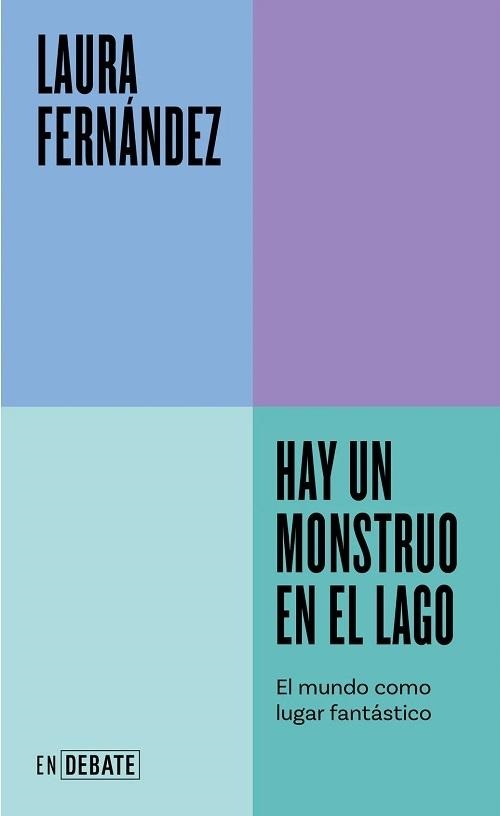- Books
- 7 de June de 2024
- No Comment
- 10 minutes read
Faith and Tourism: Walking with the Loch Ness Monster

Hay un monstruo en el lago
El mundo como lugar fantástico


Faith and Tourism: Walking with the Loch Ness Monster
The new book by the tireless Laura Fernández, who still has to her credit recent releases such as the monumental novel La señora Potter no es exactamente Santa Klaus” (Random House, 2021) and the short story collection Damas, caballeros y planetas (Random House, 2023), brings some novelties and a shift in literary genre. There is no doubt that Hay un monstruo en el lago is an essay, not least because it has been published in a collection of short essays. Yet, it is not merely an essay. I would say it is also a novelistic text, that is to say, narrative, and in Fernández’s style—full of capital letters, irony, asides, surprises, and vivacity, starring Laura Fernández herself. It is also a chronicle, the account of a trip to Inverness and its surroundings, and a report. I think it is too often forgotten that Laura Fernández is one of the best cultural journalists working in the country today. If you visit her author page on El País, you will be amazed by the number of years she has covered all the coolest topics: the best series, the best books, the rarest ones, the best music, and the most intelligent and lively prose one could wish for.
In her presentations and public appearances, the author never tires of saying that her animated inanimate objects (Laura Fernández’s readers will know what I’m talking about) are aspects of her biography or projections of her states of mind. This might mean that a coffee pot, a suitcase, a ghost, or a dinosaur can become vehicles of the authorial voice, somewhat like when Rick (from “Rick and Morty”) gets involved with uniconscious world collectives that speak with a single integrated voice. But here, the novelty is that the dinosaur (because Nessie is a plesiosaur, in case you didn’t know) seems not to exist. And what does this Fernándezian anomaly provoke? Through whom does the narrator speak this time, since the dinosaur this time seems unable to exist? With whom does she identify? Answer: with the NESSIE HUNTERS, the motley collective of believers who spend their lives trying to photograph or record the monster, the plesiosaur, which might have reached the world’s most famous lake through some of the mysterious tunnels connecting it to the North Sea. Among these monster hunters, there are truly colourful characters, such as the scammer and sexual predator Frank Searle, who sold fake photographs that were reproductions of postcards of apatosaurs, and who set up camp and later a caravan by the lake for decades to recruit lovers; or the surgeon who photographed a little toy at the behest of a failed film director to simulate the most well-known photo of the monster; or the more honest historians who somehow believed in something and were as noble as Agent Mulder (the praised and missed Tim Dinsdale, for example). Or like the Torquils, who sold the sailboat they lived on to buy a military truck that served as both home and operations centre to try to locate Nessie, among many others with the strangest biographies.
Therefore, the book does not focus on the peculiar believed or supposed existence of the Loch Ness monster but reflects, like Temporada alta (Sloper, 2019) by Nadal Suau, on the semi-religious reality of tourism and the peculiarities it engenders. For example, a competition between typical Highland cow plushies and plesiosaur dolls, or themed cruises. Or the fact that the couple who first raised the possibility of Nessie’s existence in 1933 did so, inspired by the film King Kong, to attract travellers to their area and to their unknown hotel.
Laura Fernández unveils the intricacies of a real story too implausible with her characteristic lively and intelligent style. J. G. Ballard already warned us that the greatest oddities did not need to be sought on Mars or Venus, because our own architectures and human landscapes like Empuriabrava or Benidorm were sufficiently disturbing to require leaving our world in search of deep introspections. In this case, what is disturbing is the amount of desire or faith that a dubious story about a monster that could be 1,500 years old can arouse, because it turns out that St. Columba had already seen it devouring some peasants in the 6th century, as recorded in an obscure chronicle. In this sense, Laura Fernández also occasionally approaches philosophy, because no one is sure what kind of reality Nessie is: a semi-fact? A semi-phenomenon? A very serious hallucination? A social suggestion? A desire? Because, “unlike the ghosts of Boleskine House, (NESSIE) could physically prove its existence, and what would happen if it did? What would happen if it appeared? Here is something that even fiction has not dared to imagine” (p. 97); that is to say, in this chronicle of real events, everything is based on the most implausible possible, and thus the Nessie Hunters live in a permanent state of parousia anxiety.
After much contemplation by the author, the Monster (sorry, the Monstress) would come to be the guarantee that we can live for an imagination that shatters all common sense, inhabiting a concentrated journey, tirelessly scanning a kind of nothingness, because the monster’s story is nothing more than a non-story, that is, a succession of specific, individual, or collective sightings, along with another succession of more or less blatant and more or less intermittent scams.
A series of scams that would have added excitement and poetry to life, there is no dispute about that. Truly unusual things are explained here, such as the fact that the famous Satanist magician Aleister Crowley considered Nessie his pet and even fed it like a dog (a sheep every Saturday), because he lived for a time in the haunted mansion located on the shore of Loch Ness, called Boleskine, full of ghosts and disturbing noises, like the detonation of a remote suicide. A house that was in turn acquired by Jimmy Page and is considered the origin of the curse that hung over his legendary hard rock band, Led Zeppelin.
A series of scams or hallucinations that even reached the magazine Nature or the British Parliament. Because quite a bit of politics was made over Nessie, especially in the era of Margaret Thatcher and also after the end of the war: “In the 1960s, it was considered that if NESSIE appeared on the loch’s shore, if it was captured there, it would belong, according to royal prerogative—that is, the series of privileges and immunities belonging to the British Crown—to the Queen. Therefore, it would be protected by the laws of something called Royal Fish, because the creature would be considered a kind of enormous royal fish. A fish that could, however, walk or make its way to the shore” (p. 78); and the fact is that many had seen the monster strolling calmly on land…
Conclusion: in this story, the least strange thing is the plesiosaur, and the most surreal thing is the human being: “When something called The International Loch Ness Monster Search Party, that is, an expedition of supposed Japanese experts, including presumed oceanographers and biologists and who knows what else, and led by a guy—Yoshio Kou—who claimed to count among his friends Tom Jones and Muhammad Ali, the boxer, set up camp on one of the shores of the loch and decided they were going to find (THE MONSTER), the British authorities trembled. Because what if it happened? What if those people found it and took it away?” (p. 87). Moreover, at that time it was believed that the black waters of the loch hid a family of wonderful greenish-blue plesiosaurs… But the authorities were soon reassured: Kou was just an actor. His entourage was not made up of scientists but a bunch of showbiz Scotch lovers, and the amphibious dinosaurs did not appear. Anyone who knows Laura Fernández a bit or has frequented her public appearances will have realized that she somehow writes as she speaks, lives as she writes, in a torrent of uncontrolled wisdom that triggers chain reactions from her articles and narratives, and also in this essayistic chronicle she has just published, Laura Fernández in pure form, multi-level, wild, and, at the same time, so approachable.
Title: Hay un monstruo en el lago. El mundo como lugar fantástico
Author: Laura Fernández
ISBN: 978-84-19951-14-4
Publisher: Debate
Language: Spanish
Number of pages: 120
Publication date: June 2024
Source: educational EVIDENCE
Rights: Creative Commons

